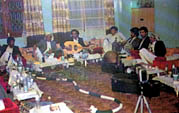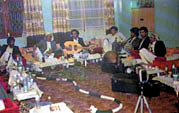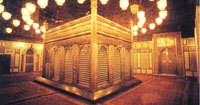
Yemeni Mowashaha [Archives:1999/05/Culture]
February 1 1999
1. History of the Yemeni Mowashaha:
The Yemeni mowashaha synchronized early in the third century after Hijrah with the Arabic mowashahha which flourished in those days in Al-Andalos (today’s Spain). After conquering Spain, the Arab people, including the Yemenis, transferred all their cultural and scientific achievements there. They presented to the Spanish people their poetry and music schools. This is mentioned in Saleem Al-Helw’s book “Creating the Mowashaha.”2.The Yemeni
Mowashaha, music and poetry:

3.The Rhythms of the Mowashaha:
If we made a study of the Yemeni mowashaha in relation to the Arabic mowashaha, we will find that the Yemeni mowashaha is almost independent in its lyrical style and composition. Even though, we find that some words mentioned in the Yemeni mowashaha (Bali bala, Ya lail dana,…) have equivalent terms in the Arabic mowashaha (Ya laili Ya Aini). We also see the same equivalence in its originally-Arabic rhythms. The large “dasa’ah,” the small “dasa’ah,” and the “sare’a” common in the Sana’ani song are actually the “sama’aeeat,”, “darag,” and “york”( Arabic rhythms). This leads us to conclude that the Yemeni mowashaha was derived from the Arabic mowashaha since it has the same accent and the same lyrical word-stock.
4. Historical Background;
Dr. Mohamed Abu Ghanem’s thesis about “The Sana’ani song” indicates that during the Omawi and Abbasi eras there was only one famous musician from Yemen, Ibn Tanboorah. The Yemeni style of singing flourished widely during the Rasoli and Bani Taher’s periods of time. But, as we came to the Imamate time, all singing activities stopped. The Imam Yahya, and his son Ahmed, forbade all kinds of singing and dancing. One of the Sana’ani upper-class people, Mr. Hasan Al-Ajami says, “During the Imam’s ruling, the Yemeni people were meeting secretly at the house of Sheikh Sa’ad Abdullah, a Yemeni lyricist, composer, and singer. During those sessions, the Yemeni artists were trying to put the new lyrics in a more traditional suit and so preserve the old and join the new. As time went by, disk companies started to appear in Aden. Those companies greatly contributed to the spread of the Yemeni song in the Arabian Peninsula and the Gulf states, and until today, those songs are the favorites of people there.
5. What the mowashaha consists of:
The lyrics in the Homaimi period deeply influenced and enriched the Yemeni mowashaha. The Homaimi poetry, as Ibrahim Al-Hadrami describes, introducing Al-Ansi’s volume of poems, is the origin of all the Yemeni literature. In its poetic composition, the Yemeni mowashaha consists of the following:
a. Beit: it is the first part of a poem, and it’s all up to the poet to determine the length of the verses.
b. Tawsheeh: verses that follow the first part of the poem differing in meter and in rhyming scheme.
c. Taqme’e: verse that comes after the Tawsheeh and that is similar to the Bait in meter and rhyming scheme.
d. Taqfeel: Verses that follow the beginning of the poem in meter and rhyming scheme.
The whole poem may consist of all these parts or, sometimes goes on the same sequence from the beginning until the end.
By Saleh Abdulbaqi,
Arts Editor
——
[archive-e:05-v:1999-y:1999-d:1999-02-01-p:./1999/iss05/culture.htm]


